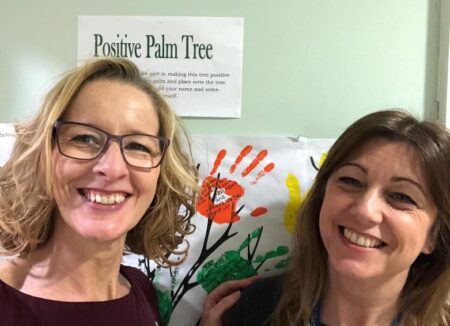Home News & Views Learning in and from practice: The Inspire Improvement Fellowship programme
Learning in and from practice: The Inspire Improvement Fellowship programme
Vikki Garrick, IBD Nurse Specialist/ GI CNS Team Lead, Royal Hospital for Children, Glasgow

As a group of Inspire Improvement Fellows we have been part of the programme for about 15 months using the Creating Caring Cultures resources. As part of the ‘Learning in and From Practice‘ ribbon we decided to undertake a peer review of ‘what’s it like to work round here’ by buddying up and visiting each other’s workplaces. And this experience proved to be (surprisingly!) valuable. It’s so easy to stay on the treadmill and become a very ‘silo thinking’ practitioner – certainly this is the culture many of us work in. However, taking the opportunity to explore others’ workplaces and see how things are done was a really enlightening experience for me.
I visited Amanda Barker in her low secure mental health unit in Bradford. Having never worked in mental health, this was a real culture shock for me. The pace, staff and client interaction and even the language used was very different to anything I had experienced before. I immediately noticed that they talked a lot more – to each other and their clients. It appeared so much less task orientated than my experiences in the acute nursing environment. Much more person-centred. Obviously, dialogue is therapy in the mental health nursing model, but nonetheless, the culture ‘felt’ different – I wasn’t expecting that.
Something about these therapeutic conversations rang true with me and it’s something I’ve noticed we don’t do in acute nursing settings. My experience is that our conversations are often very clinically orientated with less of a focus on the person themselves. Conversely what I experienced there was, although there was dialogue when clinical aspects of care were discussed, I noticed the language used was much more ‘human’ and focussed more on the person than the condition. In fact, I sat in on a report (handover) and every client was discussed using their first name only – no diagnosis, no drug therapy, no vital signs. All of this was very different to my experience in acute setting handovers where patients are often discussed according to their diagnosis or procedure.
Walking around the ward area was also very different. It was homely, bright and had lots of pictures on the walls. Coming from a paediatric setting, I was used to seeing art on the walls, but what was different here was that these collages had been produced by the clients and staff collaboratively. This was great to see and created a real feeling of identity in the unit. Speaking to the staff was also really beneficial – they clearly worked as a team and everyone commented on how the team away day (organised by Amanda) had acted as a real catalyst for positive change in their area. Also watching the interactions between clients and staff was so interesting. Staff were very open and encouraged interaction between the clients and themselves.
This is not something I see on a daily basis in the acute nursing environment. Often things are very task orientated (observations, IV fluids, drug rounds, dressing changes) – there appears to be a shift in focus from the person to the task. To some degree this can’t be helped, nursing in the acute setting is by its very nature more ‘clinically’ focussed and runs at a faster pace. However, there are many things to be learned from this experience:
- Daily de-brief after every shift to make sure staff are OK
- Integrate a more person-focussed therapeutic dialogue with our patients
- Use of more positively focussed and supportive language
- Pro-actively inquire about patients and colleagues
Finally, I have learned about the power of peer review. Both Amanda and I found it challenging and rewarding at the same time. We found having our own peer review challenging but doing one for each other immensely valuable and enjoyable. I discovered that my perspective on what was happening in my area perhaps wasn’t 100% accurate and Amanda gave me some very valuable suggestions on ways to further develop a more cohesive and caring workplace culture even though I work in an open plan office with several other specialities. It was not something I had even considered before.
Since my review, I’ve now secured a communal space for us all to communicate (across team boundaries – clinical nurse specialists, physiotherapists and dietitians) and, perhaps more importantly, to celebrate success. This feels like a real step in the right direction – it’s not one I planned for, but it feels right and that’s good.
Comments are closed.

